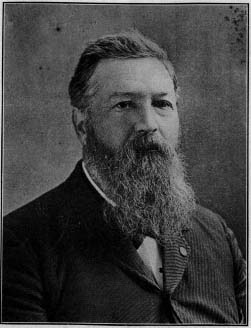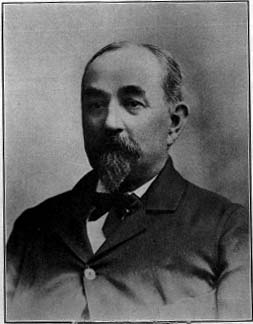|
Sketch of Holyoke by George H. Allyn, page 4 'Tis said that the Manchester Grounds derived its name about this time from a number of men from Manchester, N. H., who bought a tract of land on Taylor and Hampden streets, and erected ten houses, but the writer cannot vouch for this. The early Irish settlers included many who had worked on the dams and canals, and whose ancestors had been crushed under the weight of poverty ensuing from merciless governmental rule. Most of them, uneducated and poor, without skilled trade, they displayed magnificent fortitude in settling in a foreign and prejudiced country with no resources but those of their own thews and sinews. Other races might possibly have endured as much hardship and privations as did the early Irish people, both in their native and adopted countries, but hardly any other could have retained the same cheerful patience, the rich, merry humor, the strong family affection and sterling honesty. The early Irish settlers took things as they found them, resolving in their hearts that some day when the little town should be a bustling city their children, and their children's children should stand among the foremost, their peers in education, ability and worldly possessions. And Holyoke knows how well these resolutions were kept. The Hadley Falls bank was established in 1851, and became the Hadley Falls National bank in 1865. Mr. H.P. Terry, as a relic, has the first $5 bill issued. He was chosen cashier in 1864, serving forty years. The Holyoke Savings bank was established in February, 1855, with a strong list of incorporators. The North Chestnut street school must have been built about 1849, for organization of the "Fire District" was held there in December, 1850, and was the leading grammar school till the Appleton street building was built, in about 1868, though many other intermediate schools are mentioned by the older residents. About 1855 the inferiority of South Hadley Falls began to be manifest, and James F. Allyn removed his meat market from there to the Gallaudet block. At this period or a little later, A. & S.B. Allyn, L. & W. Perkins, and J. F. Allyn (afterward associated with J.F. Sullivan) did the meat business of the town. The marketmen butchered their own beef, and the monthly payment system with passbooks was in vogue. J.R. Ball states that in 1850 a slaughter-house stood just east of Northampton street, in the dingle, south of where Beech street intersects it, but the first slaughterhouse recalled by J.F. Sullivan was the one near the present corner of Beech and Appleton streets. Levi Perkins was a diamond in the rough, and it is related that one evening "Priest" Miller and "Priest" Walker (as the Congregational ministers of that day were styled) entered Levi's market and stood near the door. Levi kept on waiting on customers for some minutes, but finally stepped to the money drawer, took out two ten-dollar bills, handed one to each of the preachers, remarking: "There, d---n it, I know what you want," and turned again to his bench and block.
Samuel B. Allyn was a very close cattle buyer and at one time made an offer for a number of steers to Harry Will of Granby, a foeman worthy of his steel. "Do you make that as a standing offer, Mr. Allyn?" queried Colonel Harry anxiously. "Why, yes." "Well, then I guess we'll let it stand." The business portion of the town started with the building of the Gallaudet-Terry block in 1849, quickly followed by the Exchange block (which was for years the cream of the business buildings); then came the Holyoke House block, on Dwight and Main streets, the Chapin block, Main and Race streets; the Fuller block on the east side of High street, corner of Oliver street; the W. L. Martin block, northeast corner of High and Hampden streets; the Hutchins block (twice burned and rebuilt), where the Stiles block now stands; the A. & S. B. Allyn blocks, at the corner of High and Dwight streets, where the Realty Trust building now stands; the Madison Chapin block, later known as the old Ball block; the Colby-Carter block, where the Caesar Now is; the Samosett House on Maple street where T. J. Carmody now is; the Shaker block, built nearly opposite the North Chestnut street school in 1856 by a Society of Shakers, but owned by Daniel O'Connell for nearly fifty years, this last being a tenement block and mentioned only from the peculiarity of the nomenclature. Some of the merchants listed in the early 50's were Snow & Doubleday (in the rear of whose store the original Holyoke Savings bank was located), Mitchell & Pierce, clothiers and tailors; E.W. Loomis, books and confectionery; J.E. Morrill, druggist; D.P. Ludington, the Exchange Drug Store; R.B. Johnson, dry goods; W.L. Martin, coal dealer; S.H. Walker, photographer; H. Hutchins and Mrs. H. Hutchins, N.W. Quint; H. Orvis, furniture, and R.P. Crafts, general grocery store, later Crafts & Fraser. On Dwight and Main streets were J.E. Moffat, druggist; Flagg Bros., druggists; George A. Brown, stoves; E.J. Turner, shoes; Ansel Cain, jewelry; John R. Baker, general variety. On Hampden street, near High street, was Mrs. William Orrell, milliner. And let us not forget Dr. Thomas B. Shepard, who kept a drug store in the wooden ten-footers still standing at the corner of High and Hampden, though first, we think, located elsewhere. Dr. Shepard, though a worthy soul, and a college graduate, was not quite "up to snuff" mentally, and the young scapegraces of those days used to put up all sorts of jobs on him. A dozen of them would successively enter the store and call for some article which they well knew he hadn't in stock, causing the worthy druggist to load up with it, only to find that not a soul wanted it. Then they would buy some article necessitating Mr. Shepard's getting up to a high shelf, and "swipe" his cigars when his back was turned. It is really pitiful to recall that the good man was eventually reduced to bill posting, but it is to his credit that he preferred honest work to professional idleness. H. Wheeler seems to have been the only dentist for many years, and was very popular. George Brown is remembered for the exorbitant plumbing bills he used to send out, but when the indignant customer came in raging Brown would look over the bill and fly into so terrible a passion with his bookkeeper that the customer would be more than appeased. "Why, what in blazes do you mean by charging this man for eleven pounds of solder? It shouldn't be but three. Cut out that solder item entirely. And the customer would go out mollified with the most exorbitant item in his bill unchanged. Water in those days and, in fact, till 1873, was supplied from a big reservoir in the square bounded by High, Fountain, Maple and Lyman streets, with a capacity of three million gallons. This was pumped from the river and the Manchester Grounds were supplied till 1873 from a spring northwest of W.B. Wakelin's residence, the title being, as we recall it, the Mt. Tom Aqueduct Company. Many of the Irish people settled in cheap primitive habitations above the river bank from Prospect street southeasterly, and the various locations were known as the "Patch," "Black Patch," and "Black Shanties." Maple street, from Hampden street north to Lyman street, was the "tony" street from 1850 to 1865. John Delaney is said to be the first Irish citizen to reside in the charmed circle, locating on the east side, about one hundred and fifty feet. Robert G. Marsh and Jones S. Davis were the big men of the town, though Mr. Davis' fame and dignity extended to a match later day than that of Mr. Marsh. In 1855 L.A. Taber bought a lot on Dwight street, just above Linden, and built a stone house, and several brick cottages were built nearly opposite on a little avenue called Whiting avenue, possibly from W.B. Whiting, who occupied one of them. In 1857 the selectmen were authorized by the county commissioners to lay out a road from the Chester Crafts' tavern to L.A. Taber's house on Dwight street. This road was the present West Dwight street. Several houses were also built on Hampden street. In this vicinity the section came to be known as Ewingville from George C. Ewing, who had owned most of the land west of Linden street to Northampton street as far north as the south line of Beacon avenue. Dr. Pierce, Dr. Long, and Dr. N.B. Chase were physicians of this period, the Lawson Long residence still standing on Northampton street, adjoining the Charles E. Mackintosh place. Dr. Long was famous for his vapor baths, a most infernal contrivance, by which the unfortunate was stripped, wrapped in blankets, placed over a kiln of hot stones on which were thrown vinegar and other medicinal liquids, the vapor arising slowly roasting the martyr until all inflammation and his heart and soul also were nearly eliminated. The writer must admit, however, believing that this treatment saved his life when suffering from pneumonia at the tender age of four years in 1866, and trusts that the fact will not blacken his memory.
| Previous Page | Next Page |
| People & Organizations | Allyn's Sketch of Holyoke |
| Selected Advertisments | Churches | Surname Index |
© Laurel O'Donnell 1996 - 2005, all rights reserved
This document may be downloaded for personal non-commercial use only and should not be reproduced or distributed without permission. |

